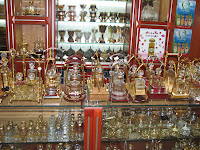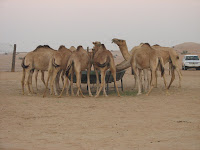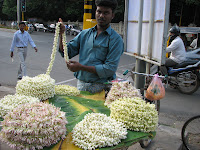Shobha & I reached Chennai 22nd morning by Blue Mountain. The train reached 4.45 am well ahead of schedule. As usual the driver from the Travels was waiting near the engine with a placard & we swiftly drove to Hotel Woodlands on Dr.Radhakrishnan Salai. We checked into Cottage No.1001 adjacent to the Sri Krishna Temple - a small beautiful temple in the Woodlands campus.
I realised that I have not visited/seen many importany memorials/monuments here though I have visited Chennai on so many occasions over the last 30-40 years. This is a city so rich in history,culture & tradition - many foreigners come from far off places in Asia, Europe & America to tour Ch

ennai . I suddenly decided to become a tourist myself and armed with my Canon Digital I set off to explore Chennai. I began with the
National Musueum , the Connemara library & Museum Theatre. I was barred entry in the Museum complex as it was still quite early. I could take a picture of the theatre from the road.
I was lucky to see a contingent of mounted police (on sleek shiny brown horses) -I smiled & waved to them & they happily waved back. Next stop was
Egmore Station, it was really crowded there & traffic was thick. However I did manage to get in some good shots .The
Egmore Station
, built in 1906,with its decorative domes is an important landmark of Chennai. All south bound trains start from this station. The area near and around Egmore Station is a busy boarding point for south bound omni-buses. The railway station features Indo Sarcenic building style and thus adds to the delight of architects and tourists.The building was designed by Robert Chisholm and consists of some illustrious domes very typical of Mughal style architecture.
My next destination was
St.Andrews Church on Ponnamallee Road - popularly referred to as 'The Kirk'. It was consecrated in 1821 AD and was the result of efforts of Major Thomas Fort de Havilland and Colonel James Caldwell. St Andrew's Kirk was built to serve the

members of the Scottish Church serving in the East India Company. It is one of the finest examples of Georgian Church architecture in Asia and was modeled on the plan for St.Martin's Lane, London. The East India Company had borne the expense of the construction of St George's Church of England and therefore decided to construct a church of the sister kingdom, Scotland. Thus St. Andrew's Kirk came into being.
Next I we

nt to
Rippon Building situated opposite Park station. Named after the Governor General of India, Lord Rippon, this building is another of the magnificent landmarks on the Chennai City and reminds the tourists of the colonial past of India. The Rippon Building is one of the most elegant examples of British architecture and has still preserved its vintage look. The building also has been a witness to a number of historical events of the past.

The Municipal Corporation of Chennai (then called Madras) settled in this building from the year 1913. The foundation stone of this building was laid in the year 1909. Two solid cast iron battle scarred cannons adorn the entrance & exit gates. A statue of Lord Rippon is mounted to the left.Th

e special attraction of this building is West Minister Quarter Chiming Clock which is quite an age old watch belonging to the year 1913.
My next stop was
Chennai Central - Celebrating centuries of service to the traveller, the Central station has indeed a long and colourful history.The Station with its distinctive red building is a combination of styles — Gothic and Romanesque. With its round arched arcading it is indeed very grand.
According to history, the Madras Railway Company began to network South India by railway as early as 1856. At that time the main statio

n was at Royapuram. In 1873, the Madras Central Station was opened with just four platforms. George Harding designed the building. Robert Chisholm suggested some improvements and trimmings, one of which is the Travancore `caps' on the towers. This redesigning effort took till 1900 to complete. The clock tower has four faces and is at a height of 136 feet. It is set to chime every quarter of an hour and every hour. Madras being the gateway to the south, in 1998, the main building was duplicated and the station now had 12 platforms. Today, approximately 200,000 people traverse the platforms at Chennai Central every day. I then drove past monumental
Southern Railway Complex & the massive
Government Hospital recently reconstructed in contemporary architecture.
Next I went past the Fort Station to
The High Court complex another landmark of Chennai. I could drive straight in through the gate without any security check. Its an amazing maze of buildings both anicient & modern, housing not only the high court but several lower courts also like distri

ct court,magistrates court,sub-court etc. It is a large campus running into several acres & well landscaped with a large variety of trees providing ample shade & beauty.The Madras High Court is believed to be the second largest judicial complex in the world, is located near the famous
Parry's Corner (Dare House) one of the important central business districts of Chennai. Madras High Court was established on June 26,1862 as one of the three Hig

h Courts of India (others at Bombay & Calcutta)) established at Presidency Towns by Letters Patent granted by Queen Victoria. The jurisdiction of the Madras High Court extends to Tamilnadu & Pondicherry.The red sand stone construction, ornamental decorations on the walls and minarets add bea

uty to this building. Inside the campus prominently located is a large statue of Manu Neethi Chozhan who represents the very embodiment of justice. You can see from the photograph a cow ringing the bell asking for justice for the death of its calf who was killed under the wheels of his sons chariot.
Manu Neethi Chozhan dispensed justice by having his own son crushed under the same chariot wheel which killed the calf !
From there I drove past
Fort St.George which houses a church as well as the Old Secretariat building where the Chief Minister & his ministers have their offices. Being a high security zone I was barred from taking any photographs.
Fort St. George occupies a place of pride and prominence in Chennai. It was built in 1640 AD, by the British East India Company under the direct supervision of Francis Day and An

drew Cogon. This bastion achieved name from St. George, the patron saint of England. The fort houses St. Mary's Church and fort museum. St. Mary's Church the oldest Anglican church in India built in 1680 and the tombstones in it's courtyard are the oldest British tombstones in India. It is surrounded by thick massive walls with a moat su

rrounding it.
South of the Fort is situated
The War Memorial a magnificent edifice built in memory of those soldiers from the Presidency who fought & died valiantly during World Wars I & II. Now inscriptions of 1948 Kashmir Aggression, 1962 War with China and also the Indo Pak War of 1971 have also been added. Incriptions are in 3 different languages-English, Hindi

& Telugu. A statue of King George stands lonely & desolate at the traffic island adjacent to this memorial.
From there on towards the Beach Road past the
Napier Bridge or Iron Bridge (a suspended deck arch bridge first completed in 1943),
Madras University campus (incorporated in 1857) & memoria

ls to Annadurai & MGR former chief ministers. Statues of Kannagi, Avvaiyar, Tiruvalluvar, Kamarajar,Periyar, Subhas Chandra Bose, Gandhi, Bharathi Dasan, Chevalier Sivaji Ganesan & others adorn the drive along the Beach Road. On my right I pass through Ezhilagam (housing state govt. offices), TWAD Board office,
Presidency College campus,
Vivekanandar Illam ( formerly called Ice House-built 160 years a

go it was used to store ice from 1842 to 1880), &
Queen Mary's College before reaching the architecturally marvellous office of the DGP. At this traffic junction is installed a pillar with Lion Capital of Asoka mounted with four lions atop & another pillar carrying a clock courtesy Simpson & Co. The light house is visible across from this point.
....................................to be continued
 g. Places visited were the Gold Souk & Carrefour a large supermarket chain. Souk is an Arabic term for market. Lunch was arranged at Al Ibrahimi Palace Restaurant near the New Burjuman Centre,Karama. Food served there was Indian & extremely delicious. The ambience was nice & friendly. It is reported to be owned by a Pathan - the door keeper was
g. Places visited were the Gold Souk & Carrefour a large supermarket chain. Souk is an Arabic term for market. Lunch was arranged at Al Ibrahimi Palace Restaurant near the New Burjuman Centre,Karama. Food served there was Indian & extremely delicious. The ambience was nice & friendly. It is reported to be owned by a Pathan - the door keeper was a tiny Pathan about 3' tall & he is a unique attraction here. Next part of the tour was a visit to the wild wadi water park. As Shobha & I were not keen on water sports we decided to give it the skip and instead decided to explore old Dubai a bit on our own. (Log on to below website if you want to know more about Wild Wadi. http://en.wikipedia.org/wiki/Wild_Wadi_Water_Park)
a tiny Pathan about 3' tall & he is a unique attraction here. Next part of the tour was a visit to the wild wadi water park. As Shobha & I were not keen on water sports we decided to give it the skip and instead decided to explore old Dubai a bit on our own. (Log on to below website if you want to know more about Wild Wadi. http://en.wikipedia.org/wiki/Wild_Wadi_Water_Park) the Dubai Souks.
the Dubai Souks. eira near the old docks and sell gold jewellery, traditional spices, perfumes and antiques.
eira near the old docks and sell gold jewellery, traditional spices, perfumes and antiques. incese, cinnamon, incense, dried fruit and nuts imported from all over the Middle East. The spices are sold straight out of large open sacks. We bought Irani dates,saffron,dalchini & frankincese(dhoop). We did some aggressive bargaining and could drive down quoted prices by half !
incese, cinnamon, incense, dried fruit and nuts imported from all over the Middle East. The spices are sold straight out of large open sacks. We bought Irani dates,saffron,dalchini & frankincese(dhoop). We did some aggressive bargaining and could drive down quoted prices by half !
 Rd. and crossed into Old Baladiya St. adjacent to the gold souk.
Rd. and crossed into Old Baladiya St. adjacent to the gold souk. selling a variety of perfumes with a thousand aromas ranging from traditional Arabic Ittars which are strong & spicy to the latest designer brands with light floral aromas. We did end up buying some perfumes and got some good bargains.
selling a variety of perfumes with a thousand aromas ranging from traditional Arabic Ittars which are strong & spicy to the latest designer brands with light floral aromas. We did end up buying some perfumes and got some good bargains. Hotel.
Hotel.













































